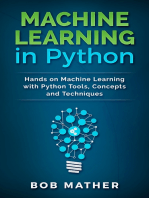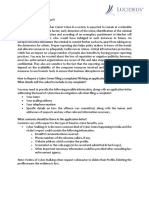An Introduction To Recursion, Part 1 - Topcoder
Uploaded by
RaJu SinGhAn Introduction To Recursion, Part 1 - Topcoder
Uploaded by
RaJu SinGh10/31/2016
AnIntroductiontoRecursion,Part1topcoder
MENU
JOIN
FIND MEMBERS BY USERNAME OR SKILL
JOIN
LOG IN
COMPETE
DESIGN CHALLENGES
DEVELOPMENT CHALLENGES
DATA SCIENCE CHALLENGES
COMPETITIVE PROGRAMMING
LEARN
GETTING STARTED
DESIGN
DEVELOPMENT
DATA SCIENCE
COMPETITIVE PROGRAMMING
COMMUNITY
OVERVIEW
TCO
PROGRAMS
FORUMS
STATISTICS
EVENTS
BLOG
An Introduction to Recursion, Part 1
Byjmzero TopCoder Member
Discuss this article in the forums
Recursion is a wonderful programming tool. It provides a simple, powerful way of approaching a variety of problems. It is often hard, however, to see how a problem can be
approached recursively; it can be hard to think recursively. It is also easy to write a recursive program that either takes too long to run or doesnt properly terminate at all. In this
article well go over the basics of recursion and hopefully help you develop, or refine, a very important programming skill.
What is Recursion?
In order to say exactly what recursion is, we first have to answer What is recursion? Basically, a function is said to be recursive if it calls itself. Below is pseudocode for a recursive
function that prints the phrase Hello World a total of count times:
https://www.topcoder.com/community/datascience/datasciencetutorials/anintroductiontorecursionpart1/
1/4
10/31/2016
AnIntroductiontoRecursion,Part1topcoder
functionHelloWorld(count)
{
if(count<1)return
print("HelloWorld!")
HelloWorld(count1)
}
It might not be immediately clear what were doing here so lets follow through what happens if we call our function with count set to 10. Since count is not less than 1, we do
nothing on the first line. On the next, we print Hello World! once. At this point we need to print our phrase 9 more times. Since we now have a HelloWorld function that can do just
that, we simply call HelloWorld (this time with count set to 9) to print the remaining copies. That copy of HelloWorld will print the phrase once, and then call another copy of
HelloWorld to print the remaining 8. This will continue until finally we call HelloWorld with count set to zero. HelloWorld(0) does nothing; it just returns. Once HelloWorld(0) has
finished, HelloWorld(1) is done too, and it returns. This continues all the way back to our original call of HelloWorld(10), which finishes executing having printed out a total of 10
Hello World!s.
You may be thinking this is not terribly exciting, but this function demonstrates some key considerations in designing a recursive algorithm:
1. It handles a simple base case without using recursion.
In this example, the base case is HelloWorld(0); if the function is asked to print zero times then it returns without spawning any more HelloWorlds.
2. It avoids cycles.
Imagine if HelloWorld(10) called HelloWorld(10) which called HelloWorld(10). Youd end up with an infinite cycle of calls, and this usually would result in a stack
overflow error while running. In many recursive programs, you can avoid cycles by having each function call be for a problem that is somehow smaller or simpler than the
original problem. In this case, for example, count will be smaller and smaller with each call. As the problem gets simpler and simpler (in this case, well consider it simpler
to print something zero times rather than printing it 5 times) eventually it will arrive at the base case and stop recursing. There are many ways to avoid infinite cycles, but
making sure that were dealing with progressively smaller or simpler problems is a good rule of thumb.
3. Each call of the function represents a complete handling of the given task.
Sometimes recursion can seem kind of magical in the way it breaks down big problems. However, there is no such thing as a free lunch. When our function is given an
argument of 10, we print Hello World! once and then we print it 9 more times. We can pass a part of the job along to a recursive call, but the original function still has to
account for all 10 copies somehow.
Why use Recursion?
The problem we illustrated above is simple, and the solution we wrote works, but we probably would have been better off just using a loop instead of bothering with recursion.
Where recursion tends to shine is in situations where the problem is a little more complex. Recursion can be applied to pretty much any problem, but there are certain scenarios for
which youll find its particularly helpful. In the remainder of this article well discuss a few of these scenarios and, along the way, well discuss a few more core ideas to keep in mind
when using recursion.
Scenario #1: Hierarchies, Networks, or Graphs
In algorithm discussion, when we talk about a graph were generally not talking about a chart showing the relationship between variables (like your TopCoder ratings graph, which
shows the relationship between time and your rating). Rather, were usually talking about a network of things, people, or concepts that are connected to each other in various ways.
For example, a road map could be thought of as a graph that shows cities and how theyre connected by roads. Graphs can be large, complex, and awkward to deal with
programatically. Theyre also very common in algorithm theory and algorithm competitions. Luckily, working with graphs can be made much simpler using recursion. One common
type of a graph is a hierarchy, an example of which is a businesss organization chart:
Name
Manager
Betty
Sam
Bob
Sally
Dilbert
Nathan
Joseph
Sally
Nathan
Veronica
Sally
Veronica
Sam
Joseph
Susan
Bob
Veronica
In this graph, the objects are people, and the connections in the graph show who reports to whom in the company. An upward line on our graph says that the person lower on the
graph reports to the person above them. To the right we see how this structure could be represented in a database. For each employee we record their name and the name of their
manager (and from this information we could rebuild the whole hierarchy if required do you see how?).
https://www.topcoder.com/community/datascience/datasciencetutorials/anintroductiontorecursionpart1/
2/4
10/31/2016
AnIntroductiontoRecursion,Part1topcoder
Now suppose we are given the task of writing a function that looks like countEmployeesUnder(employeeName). This function is intended to tell us how many employees report
(directly or indirectly) to the person named by employeeName. For example, suppose were calling countEmployeesUnder(Sally) to find out how many employees report to
Sally.
To start off, its simple enough to count how many people work directly under her. To do this, we loop through each database record, and for each employee whose manager is
Sally we increment a counter variable. Implementing this approach, our function would return a count of 2: Bob and Joseph. This is a start, but we also want to count people like
Susan or Betty who are lower in the hierarchy but report to Sally indirectly. This is awkward because when looking at the individual record for Susan, for example, its not
immediately clear how Sally is involved.
A good solution, as you might have guessed, is to use recursion. For example, when we encounter Bobs record in the database we dont just increment the counter by one. Instead,
we increment by one (to count Bob) and then increment it by the number of people who report to Bob. How do we find out how many people report to Bob? We use a recursive call
to the function were writing: countEmployeesUnder(Bob). Heres pseudocode for this approach:
functioncountEmployeesUnder(employeeName)
{
declarevariablecounter
counter=0
foreachpersoninemployeeDatabase
{
if(person.manager==employeeName)
{
counter=counter+1
counter=counter+countEmployeesUnder(person.name)
}
}
returncounter
}
If thats not terribly clear, your best bet is to try following it through line-by-line a few times mentally. Remember that each time you make a recursive call, you get a new copy of all
your local variables. This means that there will be a separate copy of counter for each call. If that wasnt the case, wed really mess things up when we set counter to zero at the
beginning of the function. As an exercise, consider how we could change the function to increment a global variable instead. Hint: if we were incrementing a global variable, our
function wouldnt need to return a value.
Mission Statements
A very important thing to consider when writing a recursive algorithm is to have a clear idea of our functions mission statement. For example, in this case Ive assumed that a
person shouldnt be counted as reporting to him or herself. This means countEmployeesUnder(Betty) will return zero. Our functions mission statment might thus be Return the
count of people who report, directly or indirectly, to the person named in employeeName not including the person named employeeName.
Lets think through what would have to change in order to make it so a person did count as reporting to him or herself. First off, wed need to make it so that if there are no people
who report to someone we return one instead of zero. This is simple we just change the line counter = 0 to counter = 1 at the beginning of the function. This makes sense, as
our function has to return a value 1 higher than it did before. A call to countEmployeesUnder(Betty) will now return 1.
However, we have to be very careful here. Weve changed our functions mission statement, and when working with recursion that means taking a close look at how were using the
call recursively. For example, countEmployeesUnder(Sam) would now give an incorrect answer of 3. To see why, follow through the code: First, well count Sam as 1 by setting
counter to 1. Then when we encounter Betty well count her as 1. Then well count the employees who report to Betty and that will return 1 now as well.
Its clear were double counting Betty; our functions mission statement no longer matches how were using it. We need to get rid of the line counter = counter + 1, recognizing
that the recursive call will now count Betty as someone who reports to Betty (and thus we dont need to count her before the recursive call).
As our functions get more and more complex, problems with ambiguous mission statements become more and more apparent. In order to make recursion work, we must have a
very clear specification of what each function call is doing or else we can end up with some very difficult to debug errors. Even if time is tight its often worth starting out by writing a
comment detailing exactly what the function is supposed to do. Having a clear mission statement means that we can be confident our recursive calls will behave as we expect
and the whole picture will come together correctly.
In Part 2, well look at how recursion works with multiple related decisions, such as navigating a maze, and with explicit recursive relationships.
continue to Part 2
More Resources
Member Tutorials
Read more than 40 data science tutorials written by topcoder members.
Problem Set Analysis
Read editorials explaining the problem and solution for each Single Round Match (SRM).
https://www.topcoder.com/community/datascience/datasciencetutorials/anintroductiontorecursionpart1/
3/4
10/31/2016
AnIntroductiontoRecursion,Part1topcoder
Data Science Guide
New to topcoder's data science track? Read this guide for an overview on how to get started in the arena and how competitions work.
Help Center
Need specifics about the process or the rules? Everything you need to know about competing at topcoder can be found in the Help Center.
Member Forums
Join your peers in our member forums and ask questions from the real experts - topcoder members!
OTHERS
SITEMAP
ABOUT US
CONTACT US
HELP CENTER
PRIVACY POLICY
TERMS
Topcoder is also on
2016 Topcoder. All Rights Reserved
https://www.topcoder.com/community/datascience/datasciencetutorials/anintroductiontorecursionpart1/
4/4
You might also like
- Programming and Data Structures: Debasis SamantaNo ratings yetProgramming and Data Structures: Debasis Samanta46 pages
- Prof. S.M. Lee Department of Computer ScienceNo ratings yetProf. S.M. Lee Department of Computer Science61 pages
- Data Structures and Algorithms: RecursionNo ratings yetData Structures and Algorithms: Recursion27 pages
- D7 Recursive Problem Solving and Intro to BacktrackingNo ratings yetD7 Recursive Problem Solving and Intro to Backtracking30 pages
- Day 06 - Enum, Recursion, Exceptions and Text IONo ratings yetDay 06 - Enum, Recursion, Exceptions and Text IO77 pages
- Recursion: CS 367 - Introduction To Data StructuresNo ratings yetRecursion: CS 367 - Introduction To Data Structures20 pages
- Listing 1. First Try at Factorial FunctionNo ratings yetListing 1. First Try at Factorial Function19 pages
- CSC-335 ADT's & Data Structures (Chapter 10 - ADT Implementation: Recursion, Algorithm Analysis, and Standard Algorithms)No ratings yetCSC-335 ADT's & Data Structures (Chapter 10 - ADT Implementation: Recursion, Algorithm Analysis, and Standard Algorithms)32 pages
- Recursion: Genome 559: Introduction To Statistical and Computational GenomicsNo ratings yetRecursion: Genome 559: Introduction To Statistical and Computational Genomics42 pages
- Machine Learning in Python: Hands on Machine Learning with Python Tools, Concepts and TechniquesFrom EverandMachine Learning in Python: Hands on Machine Learning with Python Tools, Concepts and Techniques5/5 (10)
- Machine Learning in Python: Hands on Machine Learning with Python Tools, Concepts and TechniquesFrom EverandMachine Learning in Python: Hands on Machine Learning with Python Tools, Concepts and Techniques5/5 (1)
- Howtoreportcybercrimeinindia 141202025406 Conversion Gate02No ratings yetHowtoreportcybercrimeinindia 141202025406 Conversion Gate023 pages
- GATE 2016 Topper Interview - Vaijenath Biradar (AIR 13 CS)No ratings yetGATE 2016 Topper Interview - Vaijenath Biradar (AIR 13 CS)5 pages
- CSE 550: An Introduction To Computer Systems ResearchNo ratings yetCSE 550: An Introduction To Computer Systems Research7 pages
- Spot Assessment 2018 Mock Test Grade 3: General Instructions For Answering Directions For StudentsNo ratings yetSpot Assessment 2018 Mock Test Grade 3: General Instructions For Answering Directions For Students7 pages
- Calculating Statistics From Group Continuous DataNo ratings yetCalculating Statistics From Group Continuous Data3 pages
- National University of Computer & Emerging Sciences: Internet StructureNo ratings yetNational University of Computer & Emerging Sciences: Internet Structure17 pages
- (HANDOUTS) The Political Self and Being FilipinoNo ratings yet(HANDOUTS) The Political Self and Being Filipino1 page
- PRR 16355 Combined Schaaf Responses PDFNo ratings yetPRR 16355 Combined Schaaf Responses PDF100 pages
- Ibm Websphere Iis Datastage Enterprise Edition V7.5No ratings yetIbm Websphere Iis Datastage Enterprise Edition V7.511 pages
- Economic Geography:: Buy Now Buy Now Buy NowNo ratings yetEconomic Geography:: Buy Now Buy Now Buy Now8 pages
- The Essentials of Chilled Beams - Part 1: Skills WorkshopNo ratings yetThe Essentials of Chilled Beams - Part 1: Skills Workshop3 pages
- B00-MT-PRO-00045 - 0 RTR Validation ReportNo ratings yetB00-MT-PRO-00045 - 0 RTR Validation Report16 pages
- Understanding The Zodiac Signs and The Wheel of Life An Esoteric and Practical Look100% (1)Understanding The Zodiac Signs and The Wheel of Life An Esoteric and Practical Look9 pages
- An Organizational Study On Sri Shanmugavel Mills (P) LTDNo ratings yetAn Organizational Study On Sri Shanmugavel Mills (P) LTD8 pages


































































































